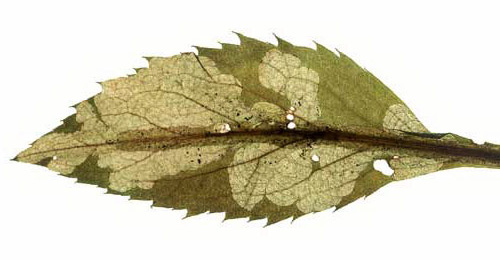|
||||||
|
SENECIO. Ragworts and Groundsels [Asteraceae] |
|
|
Thirty-eight species of Senecio are recorded in Britain. These include the native Common Ragwort (S. jacobaea), Fen Ragwort (S. paludosus), Groundsel (S. vulgaris), Heath Groundsel (S. sylvaticus), Hoary Ragwort (S. erucifolius), Marsh Ragwort (S. aquaticus), Sticky Groundsel (S. viscosus) and Welsh Groundsel (S. cambrensis) and the introduced Broad-leaved Ragwort (S. fluviatilis). Senecio fluviatilis is treated as Senecio sarracenicus by Stace (2010). Fen Ragwort (S. paludosus) is protected under Schedule 8 of the Wildlife and Countryside Act, 1981. Fifteen British miners are recorded on Senecio. The polyphagous agromyzid Liriomyza trifolii has been recorded in quarantine in Britain (Pitkin & Plant in British leafminers). See also Liriomyza species in Glasshouses and/or Quarantine Interceptions. The agromyzids Melanagromyza aeneoventris, Melanagromyza eupatorii, Melanagromyza oligophaga and Napomyza lateralis are recorded boring the stems of Senecio in Britain. Elsewhere the agromyzid Napomyza lateralis is recorded boring the stems of Senecio. The tortricid Cnephasia conspersana is recorded as a seed / shoot-feeder on Sonchus in Britain. A key to the European miners recorded on Senecio is provided in Bladmineerders van Europa. |
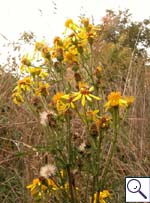 Ragwort Senecio sp. |
|
|
|
Key for the identification of the known mines of British |
||
1a > Stem miner: An external stem mine. Pupation in the mine (Spencer, 1972b: 27). |
||
|
||
Ophiomyia senecionina Hering, 1944 [Diptera: Agromyzidae]. |
||
1b > Leaf-miner |
||
2a > Leaf-miner: The mine begins as an elongated blotch overlying a strong vein; from there broad tunnels radiate that coalesce in the end. All frass is concentrated at a central point in the floor of the mine. As a result the mine has a brownish-black centre and a paler brownish green seam. The larva often (perhaps always at daylight) rests in the centre of the mine. Primary and secondary feeding lines as a rule quite clear. Pupation outside the mine. An elongated blotch centred over a vein. There are two types: greenish with a blackish centre and entirely reddish-black. |
||
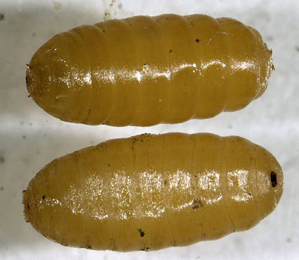 Trypeta artemisiae pupariria Image: © Willem Ellis (Bladmineerders van Europa) |
||
|
||
Trypeta artemisiae (Fabricius, 1794) [Diptera: Tephritidae]. |
||
2b > Leaf-miner: An upper surface corridor mine, becoming strongly broadened and blotch-like. The mine can occupy a considerable part of a small leaf. Mines frequently merge and then accommodate several larvae. Pupation external, in the soil. Upper-surface corridor, in the end strongly widened and blotchy; may occupy a large portion of smaller leaves. Mines may coalesce, and contain several larvae then. Primary and secondary feeding lines very conspicuous (picture). Pupation outside the mine. Makes upper surface blotches. |
||
|
||
Acidia cognata (Wiedemann, 1817) [Diptera: Tephritidae]. |
||
2c > Leaf-miner: Full depth, initially a much branched corridor, irregular in width, in the end almost a blotch. The mine has openings by which part of the frass is ejected. The larvae frequently leave the mine to restart elsewhere. Older larva live free and cause window feeding, often erasing their old mines. In Coltsfoot also pseudo-mines are made, when the larva eats away the lower epidermis with the leaf tissue, but spares the dense hair cover. |
||
|
||
Phytosciara halterata Lengersdorf, 1926 [Diptera: Sciaridae]. |
||
| 2d > Leaf-miner: The mine mine begins as a long, hairlike corridor. The last part of it runs perpendicular to a leaf segment. The part of the leaf that thereby is cut off Wiltshire, and here a large blotch is made. Frass scattered in the mine. Mine practically full-depth, yellowish green to reddish brown, with conspicuous secondary feeding lines. Pupation outside the mine. See also Seidel (1926a) for an extensive description of the mine. | ||
|
||
| Stemonocera cornuta (Scopoli, 1772) [Diptera: Tephritidae]. | ||
2e > Leaf-miner: A distinctive mine primarily above mid-rib, with irregular short lateral offshoots into leaf blade. Pupation external (Spencer, 1972: 51 (fig. 172), 55; Spencer, 1976: 270, 271 (fig. 486)). Branched, whitish, upper-surface corridor; main axis overlying the midrib; side branches overlying the main lateral veins. (In Campanula and Phyteuma the mine is much less branched, sometimes nothing more than a corridor on top of the midrib). Frass in rather long strings. Usually the mines begins as a long and narrow, shallow, tortuous lower-surface corridor that ends upon the midrib but otherwise is not associated with the leaf venation. Often this initial corridor is filled with callus, and then even less conspicuous. Pupation outside the mine. A linear mine on the upper surface, usually following the midrib and showing side branches along the veins. The frass is in strings. |
||
|
||
|
||
Liriomyza strigata (Meigen, 1830) [Diptera: Agromyzidae] |
||
2f > Leaf-miner: Broad corridor overlying the midrib. The mine has a number of side branches that distally widen strongly, and may coalesce. Primary and secondary feeding lines very conspicuous. Pupation external, in soil. |
||
|
||
|
||
Cornutrypeta spinifrons (Schroeder, 1913) [Diptera: Tephritidae]. |
||
2g > Leaf-miner: Mine linear, whitish, both upper and lower surface. Pupation internal, at the end of the mine with the anterior spiracles projecting through the epidermis (Spencer, 1976: 433). Upper-surface, less often lower-surface corridor. Frass in isolated grains. Pupation within the mine, in a, usually lower-surface, pupal chamber. A long whitish upper surface corridor, which eventually goes lower surface. |
||
|
||
Chromatomyia
horticola (Goureau, 1851) [Diptera: Agromyzidae] |
||
| 2h > Leaf-miner: A relatively long irregular linear mine, normally commencing near
the apex of the leaf and for a while following the leaf margin (Spencer,
1976: 244).
Short, broad, upper-surface corridor, sometimes forming a secondary blotch. Frass in pearl chains or strings. Pupation outside the mine; exit slit in upper epidermis. The initial mine is a corridor, which normally follows the leaf edge. It then expands to form a blotch. |
||
|
||
| Liriomyza erucifolii Meijere, 1943 [Diptera: Agromyzidae]. | ||
2i > Leaf-miner: Mine irregularly linear, long, towards end wide. Pupation external (Spencer, 1972b: 80). |
||
|
||
| Phytomyza alpina Groschke, 1957 [Diptera: Agromyzidae]. | ||
2j > Leaf-miner: Larva mining both lower and upper surface, unusually long, linear, conspicuously broad, frequently largely on the underside of the leaf. Pupation external (Spencer, 1972b: 76 (fig. 251); Spencer, 1976: 445 (fig. 780), 446). Corridor mine. The first part consists of a very long and narrow lower-surface corridor; the mine is quite shollow here, and often inconspicuous. The second part is upper-surface, uusally much shorter, and widens abruptly. Pupation outside the mine. |
||
|
||
Phytomyza marginella Fallén [Diptera: Agromyzidae]. |
||
2k > Leaf-miner: The mine begins as a long, quite narrow corridor, usually not far from the tip of a leaf segment. Usually this corridor follows the leaf margin for some distance, but it may also run freely through the blade and may then be stongly contorted. In the end the corridor is directed towards the midrib, where an elongated blotch is formed, overlying the midrib and some of the larger lateral veins. Frass in a nearly continuous line in the initial corridor, in scattered lumps in the later part of the mine. Primary and secondary feeding lines very conspicuous when seen in transparancy. Pupation outside the mine. The mine starts as a very narrow corridor, usually close to the tip of a leaf segment and following the leaf margin. The later section of the corridor approaches the main vein, where an elongated blotch is made with long broad finger like extensions that lay over the secondary veins. In the initial corridor the frass forms an almost continuous line, in the blotch it is distributed in large scattered lumps. In fresh mines the secondary feeding lines are clearly visible. |
||
|
||
Trypeta zoe Meigen, 1826 [Diptera: Tephritidae]. |
||
2l > Leaf-miner: The mine begins with a very narrow full depth corridor, that ends upon the midrib. Subsequently a broad corridor, or rather an elongated blotch, is made overlying the midrib; from here broad, lobe-like extensions are made into the blade. Frass in discrete grains. Secondary feeding lines conspicuous. The larva is capable of leaving the mine and restarting in a new leaf, in which case the association with the midrib may be lost. Pupation after vacation of the mine. |
||
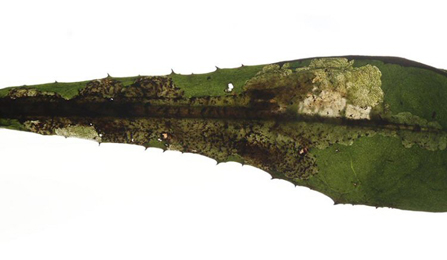 Mine of Trypeta immaculata on Taraxacum Image: Rob Edmunds (British leafminers) |
||
|
||
Trypeta immaculata (Macquart, 1835) [Diptera: Tephritidae]. |
||
2m > Leaf-miner: Rather narrow corridor, untidy and sometimes branched, starting from the base of the leaf, in particular the midrib. Sides of the corridor irregularly eaten out, not really parallel. Frass mostly present, and then in a central line. The larva is capable of leaving the mine and start a new one elsewhere. These later mines are much broader, and the frass is scattered irregularly.. |
||
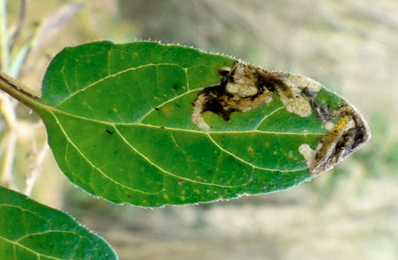 Mine of Orthochaetes insignis on Prunella vulgaris Image: © Jean-Yves Baugnée (Bladmineerders van Europa) |
||
|
||
Orthochaetes insignis (Aube, 1863) [Coleoptera: Curculionidae]. |
||
| Last updated 09-Jul-2020 Brian Pitkin | ||


